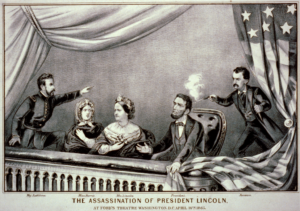Apr. 14 in U.S. military history
 1865: Four days after Gen. Robert E. Lee’s surrender at Appamatox, famed actor John Wilkes Booth shoots and mortally wounds Pres. Abraham Lincoln in the back of the head at Ford’s Theater in Washington, D.C.
1865: Four days after Gen. Robert E. Lee’s surrender at Appamatox, famed actor John Wilkes Booth shoots and mortally wounds Pres. Abraham Lincoln in the back of the head at Ford’s Theater in Washington, D.C.
1945: The Tirante (SS-240) torpedoes and sinks a Japanese ammunition ship in Cheju Harbor (modern-day South Korea). The explosion illuminates the surfaced Tirante, and as the sub rushes to escape the harbor, it launches its last two torpedoes, killing the two escort frigates in hot pursuit. Commander George L. Street is awarded the Medal of Honor for the engagement.
1969: Two North Korean Mig-21 fighters shoot down a Navy EC-121M “Warning Star” reconnaissance aircraft on an electronic intelligence-gathering mission against the Soviet Union. 30 sailors and one Marine perish in the largest single loss of life during an aircraft engagement during the Cold War.
1986: In response to a Libyan terrorist bombing in Berlin that killed two U.S. servicemen and wounded 79, Pres. Ronald Reagan orders airstrikes against Muammar Gaddafi. 45 Air Force, Navy, and Marine Corps aircraft drop 60 tons of munitions on Libyan military targets. An Air Force F-111 “Aardvark” fighter-bomber is shot down by a surface to air missile – killing the two-man crew.
Western European governments denied the U.S. access to their airspace for the strike, forcing the F-111 crews based in England to fly around Spain. The route change added 13 hours of flight time and six mid-air refuelings, making Operation El Dorado Canyon the longest fighter mission in U.S. military history.
1988: The guided missile frigate Samuel B. Roberts (FFG-58) strikes an Iranian mine in the Persian Gulf, injuring ten sailors. In four days, the United States retaliates against Iran in the largest surface engagement since World War II.